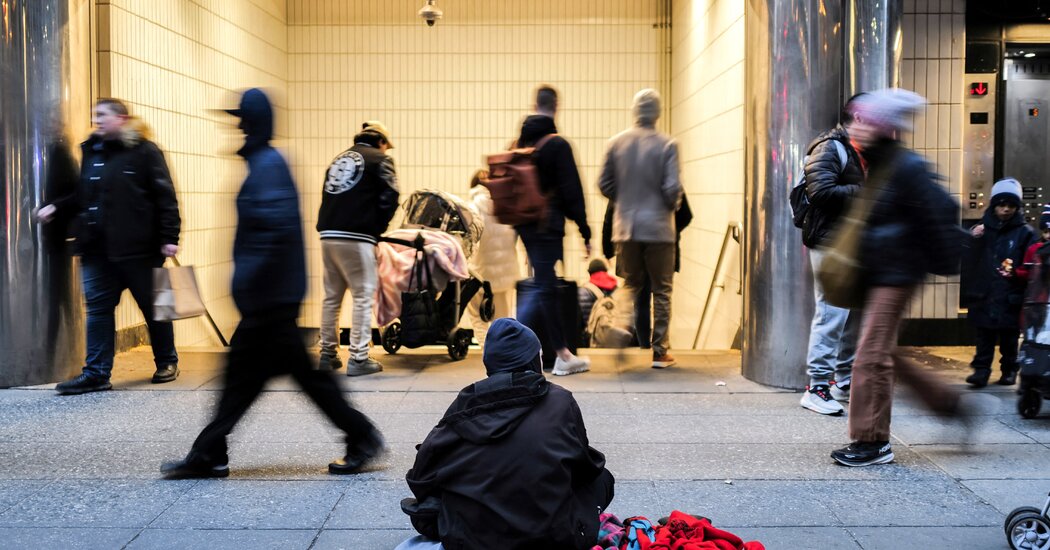The Latest:
The number of people living in the streets and subways of New York City has ticked up slightly to the highest level in nearly two decades, according to results of an annual one-night field survey that the city released on Thursday.
The survey, conducted in January, found an estimated 4,140 people living unsheltered, up 2.4 percent from last year’s 4,042 and the most since 2005, when the city began conducting the surveys.
The Cause: Migrants are not the reason, the city says.
The increase comes as the city has struggled to provide shelter to up to 70,000 migrants each night.
But the city’s social services commissioner, Molly Wasow Park, said in an interview on Thursday that the city sees no evidence of “any systemic increase in the number of unsheltered people who are asylum seekers.”
The city has been tracking unsheltered homelessness — people living on the streets, the subways or in parks — near service hubs for the migrants, like around the Roosevelt Hotel in Manhattan, and frequently checks in with outreach teams.
Last month, the city began enforcing a 30-day limit on how long single adult migrants can stay in shelters. Ms. Park said that while officials do not expect an increase in migrants living in streets and subways, it is “something we will monitor very closely.”
Finding Solutions: The city has made efforts to house people.
The increase occurred even as the city has stepped up efforts to move unsheltered people into permanent, subsidized housing. It has mostly focused on placing them in so-called supportive housing, which comes with on-site social services, or into private or semiprivate rooms in shelters with fewer rules, rather than in restrictive, barrackslike shelters.
Since Mayor Eric Adams took office in January 2022, the city has moved 2,000 unsheltered people into permanent housing. That includes 500 people whom outreach workers connected with in the subway, where the mayor made a big push to remove homeless people. The supply of the less restrictive shelter beds has grown under Mr. Adams, to 4,000 beds, and the city plans to open another 500 such beds by year’s end.
Still, Ms. Park said that decreasing street homelessness is difficult because people who sleep outside or in the transit system “have been failed by every level of society and every level of government.”
David Giffen, executive director of the Coalition for the Homeless, an advocacy group, said that while the coalition applauded the increase in shelters with fewer rules, “it’s nowhere near the number that are needed, those beds are full every single night and there are still thousands of people sleeping unsheltered in New York City.”
The trend in unsheltered homelessness depends on where you go. Compared with 2023, the number people living on streets rose 46 percent in Queens and more than doubled on Staten Island, to about 100 people, up from about 40 last year, according to someone who has seen the data but is not authorized to discuss it. In Brooklyn, the figure fell 12 percent. In Manhattan, where most unsheltered people are found, the number increased by 4 percent.
Behind the Numbers: There are questions about reliability.
Critics often question the reliability of the survey, known as the HOPE estimate, which is federally mandated nationwide and in New York is conducted by a mix of volunteers and outreach workers. By federal decree, it takes place on one night, during the coldest time of the year. (The weather on the night of the 2024 survey was nearly identical to the weather in 2023.)
Mr. Giffen said the HOPE estimate undercounts the unsheltered population so drastically that it is “meaningless.”
He said that over a year and a half in the early part of the coronavirus pandemic — when the HOPE estimate was lower than it is now — the coalition found that 9,200 people had agreed to engage with outreach workers and then accept referrals to shelters, a “fraction of a fraction” of the number who must have been unsheltered during that time.
Another measurement of unsheltered homelessness, the number of people on the caseloads of street outreach teams, shows a steeper increase than the HOPE estimate: The 2024 figure for the quarter ending March 31 was up 15 percent compared with the same period in 2023 and up 85 percent from 2022, when Mayor Adams took office. Those figures may be driven in part by increased outreach.
